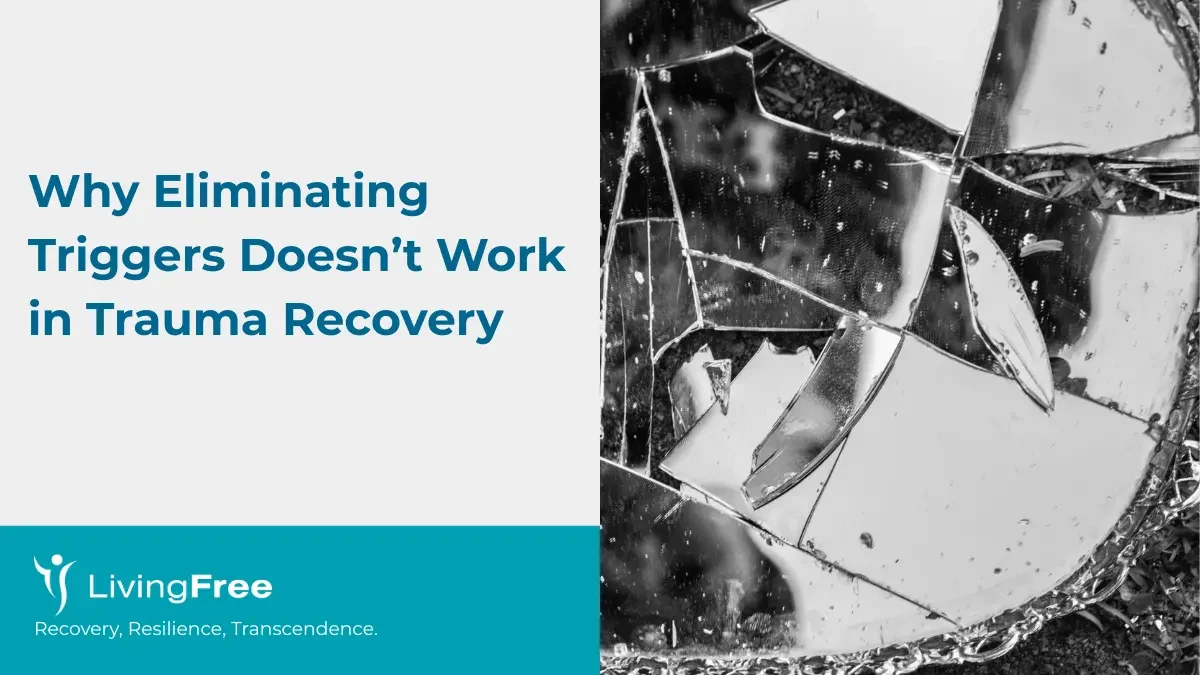When people think about trauma recovery, a common assumption is that healing means avoiding or eliminating triggers. The belief goes: if I can remove the people, places, or situations that set me off, then I will finally feel safe and recover. On the surface, this seems logical. After all, no one wants to be reminded of the most painful chapters of their life.
Yet neuroscience and clinical practice tell us something different. Avoiding triggers may bring temporary relief, but it actually strengthens trauma’s grip in the long term. At Living Free, we teach a different path: resilience is not about erasing stressors, it is about mastering the way we respond to them.
For an overview of how trauma shapes thought, emotion, and behaviour, see our article on Psychological Trauma.
Why Avoidance Fails
Short-term comfort, long-term cost
Avoidance can provide short-lived relief. It makes sense that trauma survivors might want to sidestep situations or reminders that cause distress. But over time, avoidance reinforces fear, narrows life, and prevents healing.
Studies confirm that avoidance is one of the strongest predictors of persistent PTSD symptoms. It interrupts the natural recovery process and reinforces trauma as central to a person’s identity.
We explore this dynamic further in: Avoidance in PTSD, where avoidance patterns are shown to keep symptoms alive rather than reduce them.
The impracticality of eliminating triggers
Triggers come in many forms: a smell, a sound, an anniversary date, or even a fleeting thought. They can be internal (memories, emotions, bodily sensations) or external (places, situations, voices, or visual cues) . Because they are everywhere, it is impossible to predict or eliminate them all.
The attempt to create a trigger-free world often leaves survivors hypervigilant, disconnected from loved ones, and increasingly anxious.
These reactions often overlap with PTSD symptoms such as hyperarousal and emotional numbing, which we explain in Understanding PTSD: Re-experiencing, Emotional Numbing, and Hyperarousal.
How the Brain and Body Respond
When someone encounters a trigger, the autonomic nervous system (ANS) and the hypothalamic–pituitary–adrenal (HPA) axis activate stress responses. These systems prepare the body for survival, flooding it with adrenaline, cortisol, and heightened arousal.
In unresolved trauma, these responses become dysregulated. Survivors may live in cycles of hyperarousal, emotional numbing, or compulsive avoidance. Removing stressors does not repair this dysregulation. In fact, the more a person avoids, the more sensitized the nervous system becomes .
As trauma clinician Reshie Joseph explains, resilience is not achieved by controlling the outside world. Life will always bring stressors. True recovery means mastering the nervous system’s responses so that triggers lose their power.
One common nervous system reaction is hyperarousal, which can affect sleep, concentration, and daily functioning. Learn more in Experiencing Hyperarousal.
The Costs of Avoidance
Avoidance does more than prevent healing. It often creates new problems:
- Persistent symptoms. By preventing desensitization, avoidance keeps fear pathways alive and well .
- Relational strain. Expecting loved ones to protect against all triggers can isolate survivors and create conflict.
- Addictive coping. Many turn to alcohol, drugs, or compulsive behaviours to numb the impact of triggers, which can spiral into dependency .
- Physical exhaustion. Hypervigilance and chronic stress erode the body, causing fatigue, insomnia, and somatic complaints.
Avoidance is not safety. As the Living Free manual teaches, safety emerges when survivors learn to regulate their internal state even in the presence of stress.
Many survivors misinterpret avoidance as safety. We break down this paradox in Avoidance in PTSD.
What Works Instead: Building Resilience
Research and practice consistently point toward skills-based approaches rather than avoidance.
1. Coping skills and grounding
Simple but powerful techniques help regulate the nervous system when triggered:
- Deep breathing to calm the body.
- Mindfulness to anchor in the present moment.
- Grounding exercises like noticing textures, sounds, or visual details in the environment.
- Expressive writing to process and release thoughts and emotions .
2. Evidence-based therapies
Clinical treatments address the root of trauma rather than the symptom of avoidance:
- Cognitive Behavioral Therapy (CBT) reframes distorted thoughts and beliefs.
- Eye Movement Desensitization and Reprocessing (EMDR) reduces the emotional intensity of traumatic memories.
- Prolonged Exposure Therapy teaches safe, structured confrontation with triggers to reduce avoidance.
Addressing intrusive and fragmented memories is a core part of this process, which we cover in detail in Intrusive Memories in PTSD.
3. A holistic framework: Six Domains of Recovery
At Living Free, we apply Six Domains of Trauma Recovery:
- Regulating the nervous system.
- Rewiring cognitive and belief patterns.
- Healing relational dynamics.
- Developing adaptive behaviours.
- Building physical resilience and energy capacity.
- Expanding psychological flexibility and meaning-making.
Working across these domains addresses trauma not just at the cognitive level but also at the behavioural, somatic, relational, and existential levels.
This structured approach aligns with Living Free’s trauma recovery model, first introduced in Reshie Joseph to Present New Trauma Recovery Model at NCPC 2025.
4. Social connection
Decades of research confirm that social support is one of the strongest protective factors in trauma recovery. Supportive relationships buffer against stress, reduce relapse, and provide a sense of belonging that counteracts isolation .
5. Safe but realistic environments
Avoiding dangerous situations is sensible, but trauma-informed care emphasizes preparation, not retreat. Survivors benefit from gradually engaging with life’s challenges, supported by coping strategies and therapeutic guidance.
Why This Shift Matters
The difference between avoidance and resilience is profound:
- Avoidance narrows life, reinforces helplessness, and strengthens trauma’s role in identity.
- Resilience broadens life, fosters confidence, and reframes stress as manageable.
By shifting the goal from eliminating stress to mastering responses, survivors reclaim agency. Triggers may never disappear, but their power can fade.
For more on how clinicians assess and treat these patterns, see Diagnosis and Treatment of Psychological Trauma.
Living Free’s Approach
At Living Free, we help individuals move beyond avoidance into resilience. Our structured programs integrate psychotherapy, behavioural coaching, and somatic practices. We combine research-based methods with compassionate care, guiding clients to regulate their nervous systems, reframe beliefs, heal relationships, and build practical coping strategies.
Our philosophy is simple: stress will always exist, but it does not have to define you. Recovery is possible when resilience takes the place of avoidance.
Eliminating triggers may feel like the path to safety, but it is neither possible nor effective. True trauma recovery requires building resilience, strengthening coping skills, and expanding capacity across multiple domains of life.
At Living Free, we stand by this principle in every session and program we deliver. Because the truth is clear: triggers may always exist, but they do not have to control your life.
This article is part of our wider trauma education series. To learn how trauma symptoms can sometimes be confused with other conditions, read Trauma vs. Bipolar Disorder: Why Misdiagnosis Happens.


